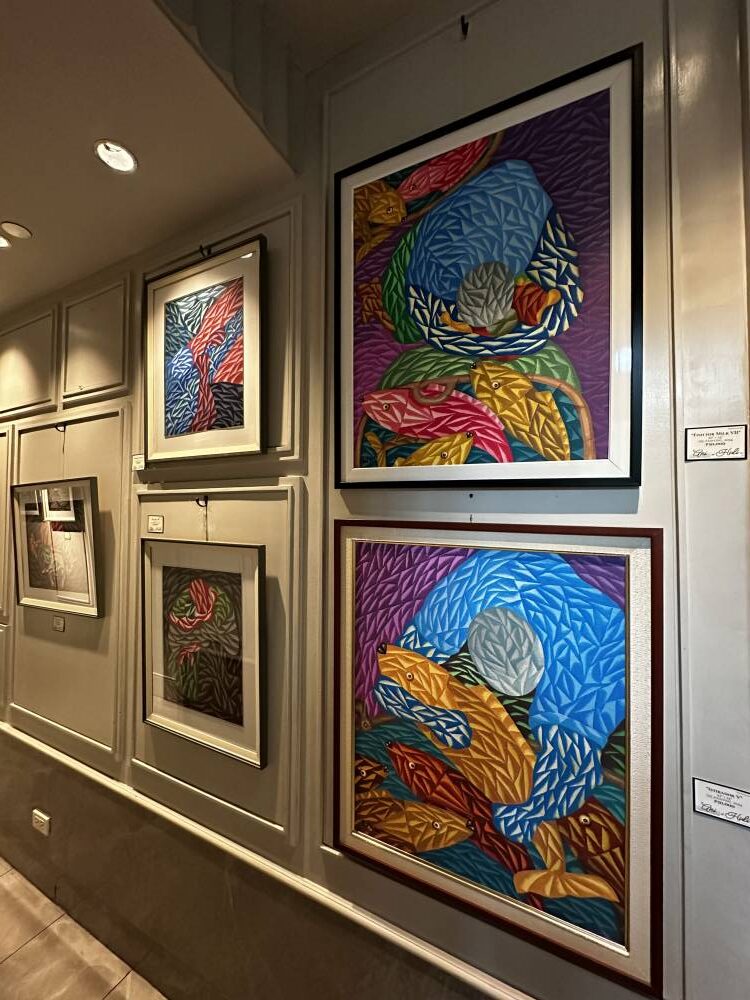
You would think that 74-year-old painter Paul Sena, who has had a decorated career of over five decades during which he has been compared to Fernando Amorsolo and celebrated by peers as a People’s Artist, has seen the last of his days as a struggling artist, hundreds if not thousands of canvases ago. The struggle continues to be real for him, though. In fact, his latest exhibit, “Ani at Huli,” was partly born of the need to raise rent money for the place he calls home—and not just for one month but for three months.
“Labing-limang beses na akong palipat-lipat ng bahay dahil hindi na ako makabayad ng upa (I’ve already transferred homes 15 times because I couldn’t pay the rent),” Sena intones in the short video that played at the exhibit launch in early July. “Ito ang totoong buhay ng artist sa Pilipinas (This is the real life of an artist in the Philippines).”
Not that he feels unaccomplished. Far from it. “Malayong-malayo na ang narating ko (I’ve come a long long way),” he says, beaming.
Don’t take that literally. He still lives in Tondo where he was born, in 1950, to a couple who had relocated in Manila. His father was a fisherman from Marinduque and his mother a farmer from La Union.
The elder Senas barely made ends meet for their seven children, from washing and ironing clothes in the community, forcing the brood to start helping out early on. For young Paul it meant waking up at 3 a.m. every day, four hours before school started, to sell komiks.
Self-taught
This proved providential in more ways than one: Aside from earning baon money for himself, it led him to discover his talent for art when he started copying the artworks in the stuff he was selling.
In fact, Sena became so well known on campus for his illustrations that when he reached high school, his teachers excused him from attending the flag ceremony. “Inaabangan na nila ako sa gate para mag-drawing ng mga visual aid para sa klase (They would wait for me by the gate to ask me to illustrate their visual aids for class),” he recalls bemusedly. He adds, “Hindi na nga nila ako pinagre-recitation eh (They’d even excuse me from recitation).”
His art continued to serve him well in college, helping him achieve a landslide victory over his rival, who got only eight votes, for PRO in the student council elections in his freshman year. Sena also participated in poster-making contests and won several gold medals. Later on he bagged top prizes in the Shell Art Competition and Metrobank Art Competition and joined group art exhibits like in Northern Motor Gallery and Little Gallery with his contemporaries Antipas Delotavo and Nemesio Miranda, to name a few.
Sena is self-taught but he considers an old Chinese painter in Tondo as some sort of mentor, or at least an inspiration. “Sunod ako ng sunod sa kanya, tinitingnan ko paano siya magpinta (I kept on following him around, observing how he painted),” he recalls. “Nakulitan siguro sa akin kaya binigyan ako ng libro, collection ng watercolor paintings niya (He got fed up and gave me a book of his watercolor paintings).” The elder painter then told Sena to copy his works, all 20 of them. “Mahirap pero natapos ko (It was difficult but I finished it).”
Like Amorsolo
It was only a matter of time before he started having his own art shows of watercolor paintings at the National Library. And it’s this set of sepia-toned social realist artworks of common folk—vendors, tellers, workers—that brought out Sena’s emotions.
“Yung climate ng emotions ko napapalabas ko sa watercolor (I’m able to showcase the climate of my emotions through watercolor),” he notes. Little did he know then that it would lead to comparisons with a Filipino visual arts titan.
“Pareho kayo ng climate ng watercolor ni Amorsolo,” Sena recalls a publisher from Atlas, a popular publishing house in the Philippines in the ’70s to the ’80s, telling him in one of his first watercolor exhibits. He was, if memory serves him right, only in his early 20s.
In the five decades since, he has dabbled in other subjects including nature, other art styles including cubism and other mediums including his own invention that’s at least a decade old—a water-mixable oil paint that’s water-proof, opaque, dust-free, odorless and long-lasting.
These particular elements in his oeuvre are fully, brilliantly showcased in “Ani at Huli (Harvest and Catch),” Sena’s eighth solo show that, according to the exhibit notes, “celebrates nature’s bounty and honors the hard work that comes with reaping the harvest, and gently reminds us of the value of safeguarding the nation’s resources because our people’s livelihood depends on it.”
For Sena, his family’s future rests on how much “Ani at Huli” will be able to sell. In particular, it will determine whether they can stay put or have to move to another place for the nth time. But regardless, what’s most important to him is the joy his works give to people.
“Hindi ko kailangang sumikat (I don’t need to be famous),” he notes. “Ang kailangan ko sumikat ang mga obra ko para mapasaya ang mga tao (What I need is for my works to be popular and thus bring joy to people).”
People’s Artist indeed. —CONTRIBUTED INQ